Back when recording was all analog, getting studio time was both difficult and expensive. It was something typically reserved for bands and artists who were on the cusp of “making it”. Then along came digital recording equipment to disrupt the scene. But like any new tech, it was extremely expensive and left room for improvement, particularly in the budget, intermediate, and prosumer sectors.
One of the biggest complaints about early digital recording gear, besides the price, was latency. Latency is the time it takes your computer to process what you’ve played and reproduce the sound. Anything above near-zero can be borderline unusable in many cases. Over time, digital gear got smaller, cheaper, and much better. Even budget USB interfaces offer incredibly-low latency and make it easy and affordable for any artist or band to record their work pretty much anywhere.
In this KillerGuitarRigs Review, we’ll be looking at 7 of the Best Low-Latency Audio Interfaces on the market today. Every interface on this list has latency under 7ms, which is roughly the amount of time it takes sound from a guitar amp 7 feet away to reach your ears. Throughout the reviews, we focused on performance, build quality, and features.
If you’re in the market for a new USB interface, this is one roundup you won’t want to miss!
Read more about our review process.
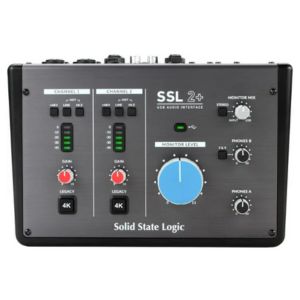
Solid State Logic SSL2+
Features: Professional grade preamps, High-current headphone amp, Legacy 4K button
Benefits: Incredible fidelity, Analog tones on demand, Unparalleled low latency performance
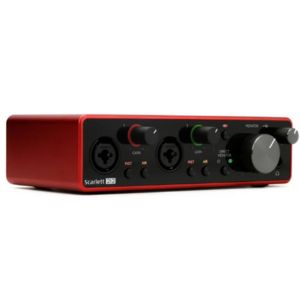
Focusrite Scarlett 2i2 Gen 3
Features: iPad Pro compatibility, Halo clipping indicators, Direct Monitor circuit
Benefits: Intuitive setup, Ultra low latency, Bright and open recordings
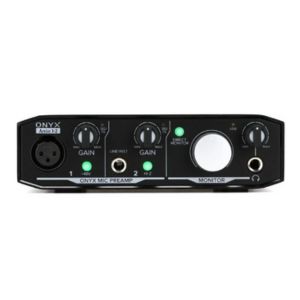
Mackie Onyx Artist 1-2
Features: Zero latency direct monitoring, 48v Phantom power, Bus powered
Benefits: Highly portable, Condenser mic compatible, awesome clarity and dynamic range
Contents
Our Top 3
If you’re looking to get a starter interface to try out home recording, you can’t go wrong with Mackie’s Onyx Artist interface, which is our Best Budget pick. While it does offer a relatively high (compared to others on this list) roundtrip latency of 6ms, you get a rugged metal-housed interface with quality preamps, a ton of software, and a price that allows you to comfortably dip your toe in home recording without spending too much.
If you’re more familiar with home recording and want to step it up a notch, the Focusrite Scarlett 2i2 offers significantly lower latency at under 3ms, excellent preamps, and AD/DA converters to get a much cleaner and fuller sound. Its ISA mic preamp emulation gives your recordings a bright and airy sound, as well as having an incredibly easy to use interface that’s practically plug and play. As such, we named it our Top Pick.
Finally, stepping up all the way to home-studio level recording, the Solid State Logic SSL2/2+ delivers 40 years of audio gear expertise in a desktop-format interface with near-zero latency at 1ms, exceptional mic preamps, and incredibly rugged construction. For those reasons, we’ve picked it as our KGR Editor’s Choice for low-latency audio interfaces.
Individual Reviews
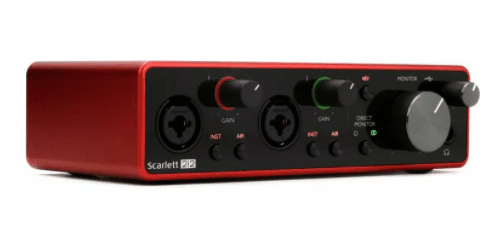
Focusrite Scarlett 2i2 3rd Gen
Super low-latency, high headroom, optimized gain, and killer preamps!.
This interface is the gold standard for prosumer level users. It's fantastically simple to use, and offers studio quality recording with no perceieved lag.
Product Highlights:
- USB 2.0 bus-powered audio interface
- 24-bit/192kHz audio
- Focusrite 3rd Gen preamps
- Air Mode to emulate ISA pres
- MAC/PC compatibility
- Massive software and VST bundled
The 3rd Gen Focusrite Scarlett 2i2 (full review here) is more than a repackaged version of the previous line. We noticed tangible improvements in dynamic range, max input level, and gain range over the 2nd Gen. The 3rd Gen also used a USB Type-C connection and came with updated drivers/software, plus significantly better headphone amp performance.
Focusrite’s iron grip in this segment relies heavily on their generous software bundles and pro-grade preamps. We tend to use Logic as our DAW, but if you’re just getting started, the bundle that comes with the Scarlett really does include everything you’ll need. Focusrite’s software bundle offers the no-frills version of Pro Tools First and Ableton Live Lite. As we mentioned, they’re great for beginners, but more experienced players might want to consider full-featured DAW.
Nevertheless, Focusrite’s bundled collection of plug-ins and loops was by far the most comprehensive in this roundup. We also discovered they’d thrown in a Plugin Collective monthly giveaway subscription. This added heaps of value to an already reasonably-priced and pleasingly low-latency audio interface.
Two of the new features for this generation are a mono and stereo summing control switch and Air Button. In ‘Air Mode’ we got an ISA mic preamp emulation, which made our recordings sound super bright and open. In terms of the AD/DA converters, preamp gain structure, and mic preamps, we found that everything sounded great and was super user-friendly.
It gave us quality recordings, both clean and with FX in the signal chain. And most notably, we found that the clipping performance of the 3rd Gen 2i2 was significantly improved over previous versions.
Verdict: It’s hard to go wrong with a Focusrite Scarlett 2i2 interface. The 3rd-generation improvements have made a good thing better. Once you spend some time with it, it’s easy to see why it’s the world’s best-selling low-latency audio interface. It’s well built, it looks great on the desktop, and it offers a lot of performance for the money.
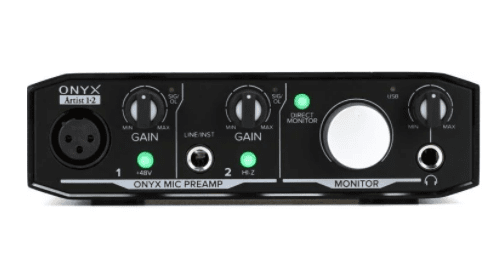
Mackie Onyx Artist 1X2
Onyx preamps, zero-latency direct monitoring at a cut-throat price.
If you're in need of a low cost, zero latency USB interface capable of recording mics, guitars and keys, this is a great choice.
Product Highlights:
- USB 2.0 bus-powered audio interface
- 24-bit/192kHz audio
- Onyx preamps
- MAC/PC compatibility
- Bundled with Tracktion T7 & FX plug-ins
If you’re at all familiar with recording gear, there’s a good chance you’ve heard a bunch of praise for Mackie and their Onyx preamps. Mackie has now taken a swing at the small-sized desktop interfaces with their Onyx Artist model, and we think they did a fantastic job.
The Mackie Onyx Artist is a bus-powered audio interface with industry-standard 24-bit/192kHz high-resolution audio. It connected over USB 2.0 and was compatible with both macOS and PC/Windows. This is the no-frills model, but it still came with a mic/instrument combo input, +48V phantom power, headphone outputs, L/R line out, and a Hi-Z switch.
The audio quality and features were generally excellent considering the price. If you need an inexpensive low-latency audio interface for recording instruments and voice, it’s a solid choice. It was clear that Mackie didn’t cut corners, despite the entry-level status of this interface. The potentiometers were built to last, the all-metal casing was rugged, and the sleek black styling had a fantastic industrial vibe to it.
Like most of the interfaces in this roundup, it included a comprehensive software and VST bundle, including the Tracktion T7 DAW and 15+ FX plugins. Using these features, we got some excellent recordings and can attest to the low-latency performance. We thought it fared quite a lot better with a clean input and FX added in the DAW, but the high-gain performance was still much better than anything else we’ve encountered in this price range.
Verdict: The Mackie Artist 1-2 packed a punch with its great-sounding preamps, zero-latency monitoring, a huge bundle of VST & software add-ons, and a world-class analog circuit. Considering the low cost, it offers a ton of great features and delivers great quality recordings. Pretty much everything you need at a price that won’t raise eyebrows.

Solid State Logic SSL2+
The most affordable way to add an SSL to your recording workflow.
This is a serious zero-lag home recording solution that offers professional standard preamps for supreme audio quality.
Product Highlights:
- USB 2.0 bus-powered audio interface
- 24-bit/192kHz audio
- Legacy 4K analog color button
- Neutrik XLR/Jack connections
- MAC/PC compatibility
After having conquered the world of large mixing boards, Solid State Logic, or SSL, has entered the compact USB-interface space with a long-awaited and highly talked about desktop interface, the Solid State Logic SSL2+.
The Solid State Logic SSL2+ stood out a little from the competition because the I/Os were on the back panel, with the controls and metering on the top. They featured Neutrik combo connectors that acted as a combo mic/line/hi-Z input with independent +48V power. They also had MIDI In/Out, a five-pin DIN port, and a five-step LED ladder meter to track input levels.
The proprietary Legacy 4K circuit did an amazing job of adding color and texture to the sound. SSL says it provides “color enhancement inspired by a 4000-Series console,” and we don’t think they’re wrong. The improvement in tone was similar to the Focusrite Air feature, but with a warmer, more vintage quality.
The software bundle included the SSL production pack, SSL Native Vocalstrip2, Drumstrip plugins, and a 6-month free subscription to other SSL Native plugin-ins. It also included Pro Tools First, 23+ production plugins and 1.5GB of samples from Loopcloud.
Verdict: Even though SSL are better known for full-size consoles and pro-grade gear, they really knocked it out of the park with this compact USB interface. The Solid State Logic SSL2+ has genuinely disrupted the market with its studio-grade performance. It presents a real challenge to the likes of the MOTU 2, Focusrite 2i2, Audient EVO, and other segment leaders. It’s ergonomic, easy to use, and hasn’t compromised at all when it comes to the kind of quality and features we’d expect from the brand.
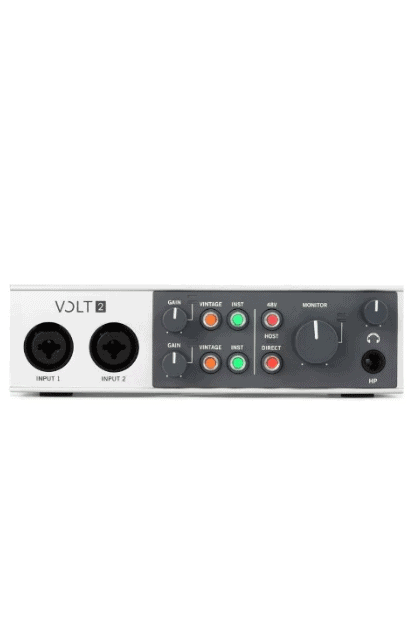
Universal Audio Volt 2
This fantastic USB interface is a true market disruptor.
This is one of the hottest new USB interfaces on the market, and it’s quickly becoming a favorite amongst the KGR staff. While it’s technically a low cost unit aimed at those who want to record at home, it has proven its worth as a cost effective unit that can deliver pro level results.
The Universal Audio Volt 2 (full review here) is a real powerhouse of an interface. Despite its small size, it offers a phenomenal feature set and fantastic recording quality that really defies its price tag.
Construction-wise, the Volt 2 was rock solid. It had a sturdy all-metal housing that should be able to take a fair amount of abuse if thrown in a gig bag or backpack. If you opt to leave it on the desktop, you’ll be pleased to know it looks as good in-person as it does in the pictures. The black and white finish really does look excellent.
It offered near-zero latency performance when the direct monitoring was activated. Even when running audio through the computer, we didn’t notice any delay. We found the control layout to be well-designed and intuitive. We were able to get recordings going without even really having to read the manual, which in our book is always a good sign.
The Volt 2 is a 2-channel model with both instrument cable and XLR input capability. Each channel has its own gain control, as well as a really clever analog vintage tube preamp option. We really liked the warmth we got with the vintage preamp activated.
If you’re looking to record a mic input, you’ll be pleased to know that it also had 48v phantom power. Another bonus was the huge suite of software that came bundled with it. It came with Ableton’s Live Lite DAW, as well as a range of great plugins to get started with.
As far as headroom is concerned, it delivered flawless performance. We experienced no clipping, even with higher gain on the vintage preamp. With the vintage mode off, the cleans were absolutely pristine.
Verdict: The Universal Audio Volt 2 was an absolute joy to use. It offered quick and easy setup and driver installation. Once it was up and running, it performed fantastically. It offered tons of headroom, excellent anti-clipping performance, distortion resistance, and near-zero latency.
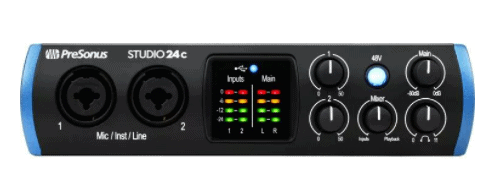
PreSonus Studio 24C 2x2
Rugged construction and fantastic AD/DA converters at an affordable price.
With this model, you're getting dual instrument/XLR inputs, phantom power, and a handy graphic clipping display for much less money than you'd think.
Product Highlights:
- Bus-Powered USB-C Audio Interface
- 2-in / 2-out + MIDI I/O
- 24-bit/192kHz audio & XMAX-L preamps
- Mac & PC compatible
- Zero-latency monitoring
- Bundled with Pro Tools & other plugins
The Presonus 24c is a bus-powered low-latency audio interface that connects over a USB-C to both PC and Mac. It’s also compatible with every major DAW. Construction-wise, it’s a rugged unit with a black center chassis laid with blue side panels.
The front panel had LED indications for the Input and Main, five knobs for parameter changes, and a +48V phantom power toggle button. This makes it easy to use just about any condenser mic without the need for external phantom power. It also featured two combo mic/instrument/line inputs that are a combination of XLR and TRS inputs.
With 24-bit recording and a sample rate of up to 192 Hz, it gave us pristine audio-recording quality. The XMAX-L preamps sound sharp and can handle a hot input with good headroom. Clipping is always a concern with USB interfaces, particularly those aimed at beginner and intermediate users, but we were pleasantly surprised in this case. The unit also had an ultra-low roundtrip latency of 3ms, which is effectively zero latency.
It’s uncommon to have MIDI input/output at this price point, so we were definitely pleased to see it on the 24c. The interface came with a generous software bundle that included the Studio One Artist (limited-version DAW), and the Studio Magic Suite (Ableton Live Lite included). It also had some VST (fx and instrument) freebies that contained high-end choices you’ll definitely be able to incorporate into your production projects.
Verdict: The PreSonus Studio 24c is a great choice for any home studio or desktop music-production rig. The headroom, gain, and clear metering were great indicators of the XMAX-L preamp’s capabilities. If you’re shopping for a low-latency, high-performance 2 x 2 interface, this Presonus offers an all-in-one solution bundled with some world-class recording software.
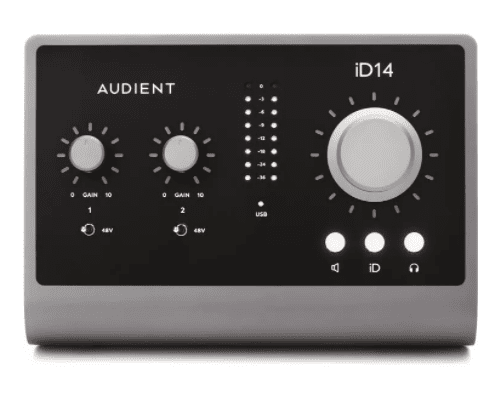
Audient iD14
A streamlined interface with ADAT expandability and excellent I/O.
Ultra high speed USB-C connectivity ensures no latency, and the simple layout makes this dual input USB interface incredibly simple to operate.
Product Highlights:
- USB-C bus-powered audio interface
- 10-in / 16-out
- 24-bit/192kHz
- 2 Audient mic preamps
- 1 discrete JFET instrument input
- 1 ADAT Input
- Bundles with Cubase LE + VST plug-ins
Audient’s iD-Series interfaces are some of the most popular premium units on the market. In January 2021, their popularity soared when Audient announced their iD14 MKII with updated features and improved performance.
This interface looked and felt premium. Yes, it was quite heavy by interface standards, but that’s to be expected with a sturdy all-metal chassis. The gun-metal finish and sleek design were reminiscent of Apple’s space-gray finishes. So if you’re a Mac user, it will look fantastic on your desktop. It had a wide range of inputs and outputs, with a 10-in/6-out panel.
We absolutely loved the JFET instrument inputs that replicated classic tube amps. In addition, the unit had ADAT expandability and mic preamps inspired by Audient’s ASP8024-HE console, which delivered flawless audio quality. The preamps sound very clean with a hint of analog warmth. Its headroom was insane, so if you’re concerned about clipping, you needn’t be with this interface.
The MkII has a wider dynamic range (126dB) than the original, plus improved audio drivers and USB 3.0 connectivity. There were also improvements in output quality and recording capabilities. The MKII now has two line outputs and two headphone outputs and, most importantly, it still retails for the same price as the first gen.
As for software, the iD14 interface was bundled with a DAW (Cubase LE) and a bag full of VST effects and instrument plug-ins.
Verdict: We really loved the Audient iD14 MKII. We found it to be compact and capable, although perhaps a little on the pricey side. But if your budget can handle it, this high-end interface is a great choice for anyone who is starting to take home recording seriously.
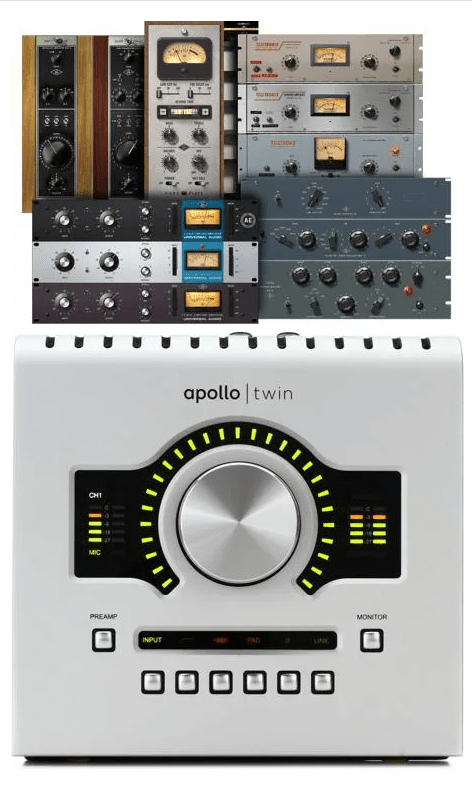
Universal Audio Apollo Twin
The Windows version of the highly acclaimed Thunderbolt-only processing beast.
This is a pro level interface with exceptional build quality, high-end features, and lightning fast performance.
Product Highlights:
- USB 3.0 bus-powered audio interface
- 2-in/6-out
- 24-bit/192kHz audio
- UAD DUO DSP processing
- Flagship Apollo circuitry & Console software
- MAC/PC compatibility
To end the roundup, we checked out one of the more premium options on the market – the Universal Audio Apollo Twin. The Apollo Twin is generally considered the unit to beat in the $500 to $1000 segment thanks to its ultra-low latency, real-time plugin-in processing, and incredible dynamic processing.
This 2-in/6-out compact interface was housed in a sturdy perforated-steel and aluminum chassis, which we thought looked fantastic. It was powered by USB-3 and featured with 2mic/line/Hi-Z inputs and 2 line outs. It also featured digitally-controlled monitor outputs with an analog attenuator that let us make the most out of our bit depth.
The best part was that all the I/Os were built-in, so there was no chance of cable fallout. The top panel housed the visual-metering LCD, multi-function rotary knob, and the associated buttons. The UAD-2 DUO DSP processing unit and Console software offered a lot of flexibility while using the controls.
It had the same circuitry as the flagship Apollo, and the uncompromising preamps really deserved their reputation as some of the best in a USB interface. We were even able to track through ‘preamp emulation’ using the Unison-enabled plug-ins.
It came bundled with Classic UAD plug-ins such as Lexicon 224, Oxford EQ, AMS RMX16, and 1176LN. Some of them may be outdated, but we still found them to be extremely versatile, and all of the highest quality.
The recording quality from this unit was fantastic. The high-gain performance was superb and we didn’t experience much in the way of clipping, whether we ran a dry signal or used a full pedal board. This is the kind of performance that really justifies the price tag.
Verdict: The Universal Audio Apollo Twin USB is the low latency audio interface to beat. Other than a potentially prohibitive cost, it’s hard to fault this interface. It’s one of the best-sounding options on the market, with the cleanest audio and near zero-latency performance. The addition of Unison technology and UA plugins make it a triple whammy for studio owners, too.
How to Choose The Right Interface for You
I/O: (Input / Output)
It’s important to identify your needs and select an interface with the right amount of inputs and outputs. The ‘right amount’ varies user to user, based on how and what you plan to record. If you want to make Instagram videos, you can likely get away with a Focusrite Solo.
A songwriter may need two inputs to record an instrument and vocals simultaneously. Similarly, you need a minimum of four (ideally 8) inputs if you intend to track drums and/or record a band or ensemble.
As for outputs, two is the bare minimum requirement to connect studio monitors. More than 2 outputs are only necessary if you use an extra pair of monitors or outboard gear as a part of your workflow.
Format
Most lower-line audio interfaces are available in desktop format. You’ll start noticing rackmount interfaces once you breach the mid-market segment. Rackmounts are preferred in pro studios, but they need to be screwed in. The desktop format is ideal for home studios.
Connectivity
The main options are USB (Mac/PC), Thunderbolt (Mac), Firewire (old Macs), or PCIe. Firewire is dated and inferior to Thunderbolt, so USB 2.0 and/or 3.0 connectors are ideal, which is why they are the most common option. We’ll steer clear of PCIe as they connect to a computer chipset and cost significantly more.
Price
Price is always a deciding factor, and for good reason. There are many components to your recording/mixing workflow that will eat away at your budget, so we always recommend starting with a well thought out spending limit to narrow down your choices.
Other Features
Preamps play a crucial role in the performance and price of an audio interface. Luckily, even the most inexpensive audio interface has a good baseline quality nowadays. Tone color, however, is a horse of a different color.
MIDI in/out will allow you to interface with older keyboards with 5-pin MIDI connectors or other hardware like arpeggiators that run with a MIDI clock out to sync tempo.
DSP or Digital Signal Processing refers to the onboard DSP. It can be non-essential for a songwriter who wants to compose/arrange and it can be non-negotiable for a mixing engineer’s latency-free monitoring mixes.
Software bundled with your interface could also mean the difference between going straight to work or spending additional money to use the interface. Check to see if the bundled software covers what you need, be it a DAW or plugins (check out our favorite amp sims here).
Final Thoughts
From tracking a live band and simple song demos, to vocal/instrument overdubs and heavy signal processing, there are a huge variety of needs when it comes to recording gear. The real challenge when looking for the best audio interface is navigating the wide-ranging use cases when it comes to connecting your guitar to a computer. There are so many options, with so many features, that it can be difficult to choose.
To recap our favorites…
If you’re just testing the waters when it comes to recording, you can’t go wrong with our Best Budget pick, the Mackie Onyx Artist. For a little more money, you can get even better latency performance from our Top Pick, the Focusrite Scarlett 2i2. If you’re taking things a little more seriously, you’ll want to take a look at our Editor’s Choice, the Solid State Logic SSL2/2+.
Also, don’t forget to check out our guide to the best home recording packages. You might discover you’re better off adding a microphone and cans to your setup right off the bat, saving yourself a few bucks in the process.

